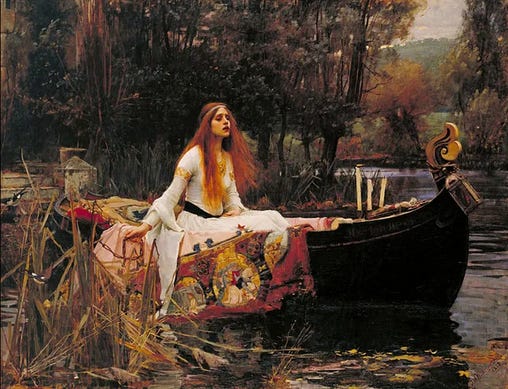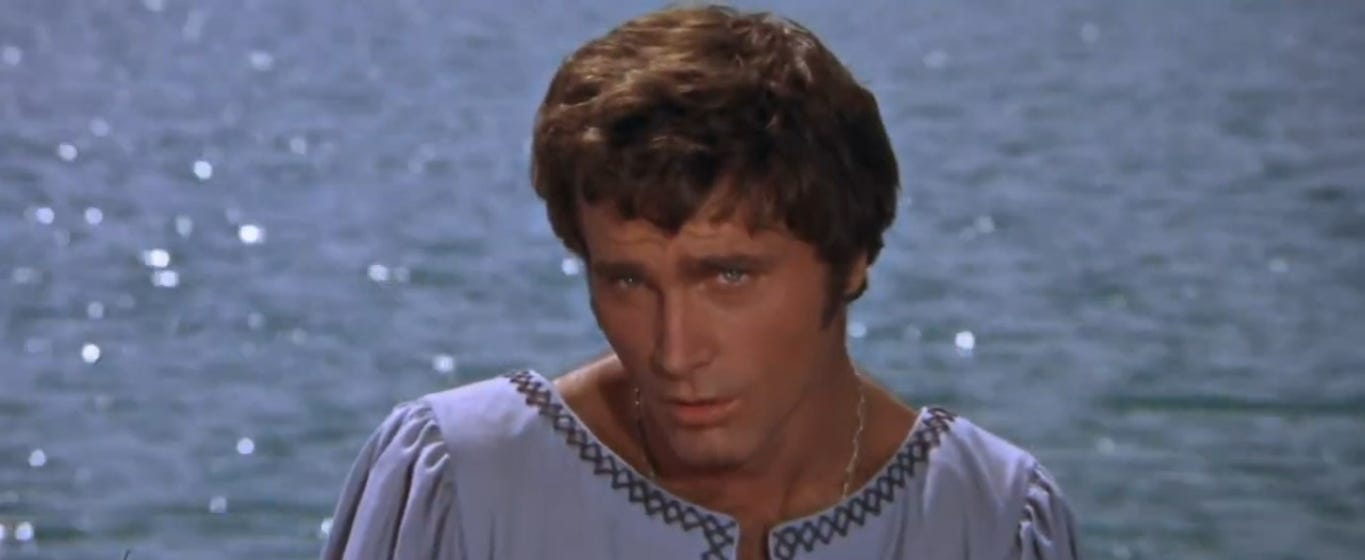GUEST POST: Camelot (1967)
One brief shining movie.
PROGRAMMING NOTE: Your usual author has kindly ceded this space to me, his mother, for Mother’s Day. That means we’re doing my favorite movie: Camelot (1967). Regularly scheduled programming on films nominated for Best Actor will resume next week.
Wikipedia describes Camelot as “a musical fantasy drama film.” With so many genres represented, it must have something for everyone!
Camelot was an adaptation of the same-named Broadway musical, which itself was an adaptation of T. H. White’s “The Once and Future King.” That novel is a sprawling work, but Camelot largely dispenses with the subplots of Merlin, most of the Knights of the Round Table, and all of the quests. Instead, it’s laser-focused on three characters: King Arthur (Richard Harris), Queen Guinevere (Vanessa Redgrave), and Sir Lancelot (Franco Nero).
Arthur, Guinevere, and Lancelot form the most famous romantasy triangle of the past 1,500 years. Here’s the tale: Arthur is King of Britain and the founder of the Round Table1 that brings peace to England. Guinevere is Arthur’s beloved wife and Lancelot is the dashing warrior who comes between them. The opening to the film tells you exactly what happens:
Guinevere, Guinevere
In that dim, mournful year
Saw the men she held so dear
Go to war for Guinevere
Arthur’s downfall comes at the hands of his bastard son Mordred (David Hemmings). As the legend goes, Arthur had an older half-sister named Morgause2 with whom he accidentally committed incest, resulting in Mordred. By the time-honored “sins of the father” doctrine, Mordred must be evil, and he undermines the Round Table and leads Arthur on the path to declaring war on Lancelot.
But enough plot! Camelot’s a musical brimming with beautiful songs with witty lyrics.
“Camelot,” where Arthur asserts that Camelot’s weather is the best—“ordained by decree!” He argues that “In short, there's simply not / A more congenial spot
For happily-ever-aftering than here / In Camelot.”“The Lusty Month of May.” (“That lovely month when everyone”—read: Guinevere—“goes blissfully astray.”)
“If Ever I Would Leave You,” Lancelot’s gorgeous musical tribute about how hot his best friend’s wife is in all four seasons.3
When the original Broadway musical was in tryouts, it ran four and a half hours.4 The film clocks in at three hours. No matter—it’s STILL my favorite movie.
Rating: 10/10 despite the bummer ending.
Cast and Crew
Richard Harris, best known nowadays as Dumbledore in the first two Harry Potter movies, actively campaigned to play Arthur. The role had been originated on Broadway by Richard Burton (who won a Tony for his work) so it was a rather big suit of armor to fill. Harris was up to the challenge. [Harris was much better in this film than he was in This Sporting Life—Ed.]
If you thought Harris’ task of living up to Richard Burton was tough, Vanessa Redgrave was taking over the role of Guinevere from Julie Andrews. Unlike Audrey Hepburn in the film adaptation of My Fair Lady, Redgrave actually did her own singing and it sounds just fine to me.
T.H. White’s “The Once and Future King” was adapted for the stage by the powerhouse duo of Alan Jay Lerner5 and Frederick Loewe. Lerner wrote both the screenplay and the song lyrics for the movie while Loewe did the music. They were also responsible for many other immortal stage and film collaborations, including “Brigadoon,” “My Fair Lady,” and “Gigi.”
Legendary producer Jack L. Warner was apparently reluctant to take on the film, despite the huge success of the previous year’s My Fair Lady. Some sources credit Camelot’s high cost6 and challenging location shoots, along with the controversial political activism of Vanessa Redgrave, as contributing to Warner’s exit from Warner Brothers. Camelot was his last film for the studio, although he continued working as an independent producer into his early 80s.
Quick Hits:
Joshua Logan directed. He was better known as a theater director, particularly for “South Pacific,” which he co-wrote with Rodgers and Hammerstein and for which he won a Tony and a Pulitzer.
Franco Nero took over the role of Lancelot from Robert Goulet. Nero was an Italian whose breakout was the hyperviolent spaghetti Western Django (1966). Camelot was his first film in English; he worked to overcome his heavy Italian accent but his singing was dubbed. Redgrave and Nero began an affair during the movie’s filming (à la Burton/Taylor in Cleopatra) and were on-again off-again until they married almost 40 years later.
David Hemmings, who played Mordred, took over the role from Roddy McDowall. Hemmings was the only trained singer in the cast, yet Mordred’s song from the musical, “The Seven Deadly Virtues,” was cut.
The Trivia
Getting right out in front of it: A genuine, verifiable, historical King Arthur doesn’t seem to have existed—or if he did, nobody can prove it.
The earliest sources for Arthur are Welsh and Breton tales from the 6th or 7th centuries, but because people were all about oral history back then, little was written down until 1138. That’s when Geoffrey of Monmouth produced his “Historia Regum Britanniae” (History of the Kings of Britain). Despite the “History” in the name, the work is partly a compilation of those centuries-old legends about a (probably) Welsh warrior chieftain, but also largely a production of Geoffrey’s vivid imagination. Much of what we think we know about Arthur appears here first: Uther, Tintagel (Arthur’s supposed Cornish birthplace), Merlin, Guinevere, Excalibur, Mordred, and Arthur’s final battle.
These were such good stories that people couldn’t help adding to them in what was essentially medieval fanfiction. Chrétien de Troyes, a French poet, wrote five works about the Knights of the Round Table in the late 12th century. His “Perceval” is the earliest known mention of the quest for the Holy Grail.7 This is also the first mention of Lancelot.
The next big moment in Arthurian literature comes to us via Sir Thomas Malory, whose “Le Morte d’Arthur” was published by William Caxton in 1485. Written in Middle English, it consists of eight volumes and features not only knights, kings, and enchanters, but also (for some reason) Romans, Ottoman Turks, giants, and fairies.
Skipping ahead to the Victorian Era, Alfred, Lord Tennyson sparked a resurgence of interest in all things Arthur when he published “Idylls of the King” beginning in 1859. It’s a cycle of twelve narrative poems in blank verse, based upon Malory but considerably expanded.8 “The Lady of Shalott,” a ballad from 1832 that was re-worked and included in the “Idylls,” is arguably the most-referenced part of the work.9

The inspiration for the film Camelot came from T. H. White’s “The Once and Future King,” which was written from 1938 to 1958.10 The first of these five novels, “The Sword in the Stone,” was adapted into a Disney film in 1963. Camelot is based on the third and fourth books: “The Ill-Made Knight” and “The Candle in the Wind.”
Camelot ends without telling the viewer about Arthur’s downfall. We see Arthur suffer Lancelot and Guinevere’s betrayal, but later he dies by the hand of his bastard son Mordred. But it’s not all bad! He’s currently taking a long nap under Glastonbury Abbey, but it’s prophesied he’ll return in Britain’s greatest hour of need to restore the kingdom.
Speed Round: Knight of the Round Table
King Arthur: the son of Uther Pendragon and Igraine. Wields the sword Excalibur, which he got from the Lady of the Lake or pulled from the stone (sources differ). Was taught by the wizard Merlin. Siblings with the enchantress Morgan Le Fay.
Lancelot, known as Lancelot du Lac (Lancelot of the Lake, as he was raised by the Lady of the Lake) and the Knight of the Cart.
Gawain, Arthur’s nephew. He’s known for his run-in with the Green Knight.
Galahad: son of Lancelot and Elaine of Corbenic. He’s the most spiritually pure of the knights, which is why he can sit in the Siege Perilous and why he’s able to survive seeing the Holy Grail.
Percival also was a knight who sought the Holy Grail, and in some of the earlier works, he’s the one who finds it (see the story of Percival and the Fisher King). He’s the father of Lohengrin, known as the Swan Knight.
Tristan: famous for his tragic romance with Iseult.
Odds and Ends
It may be apocryphal that the Broadway soundtrack was JFK’s favorite, but his presidency is known as “Camelot” anyway…“only fools never doubt”….there has never been another British King Arthur11…Camelot was nominated for five Oscars and won three (none for acting or directing)…Moss Hart directed “Camelot” on Broadway…“the adage ‘blood is thicker than water’ was invented by undeserving relatives.”
[Camelot is okay. Probably not even the best musical film of 1967, but definitely okay.—Ed.]
The Table is round so that there’s no head, meaning no superiority for any one knight. Canonically, it seated 150.
Or Morgan. Or Anna. Or Belicent. As we’ll see in the Trivia section, these legends were written by numerous people and the names are not consistent.
Some other well-known songs: “I Wonder What the King Is Doing Tonight,” “How to Handle a Woman” (answer: simply love her), “What Do the Simple Folk Do?,” and “I Loved You Once In Silence.”
Noël Coward quipped that the show was “longer than the ‘Götterdämmerung,’ and not nearly as funny.”
I had the privilege of briefly meeting Mr. Lerner near the end of his life. As one would possibly expect from a man married eight times, he was utterly charming.
Including a reported $2 million on costumes (though that was clearly money well spent).
The real Holy Grail is in the cathedral in Valencia, Spain. I’ve seen it so it must be true.
I think there is a law in England that every few hundred years or so this has to happen.
Despite being, if you ask me, kind of insipid. Elaine, the Lily Maid of Astolat, dies of her unrequited love for Lancelot and then gets floated in a barge to Camelot so Lancelot can see what he “did” to her. Sheesh.
The work gets its title from “Rex Quondam, Rexque Futurus,” which, by legend, is what Arthur’s tomb reads.
Henry VII named his firstborn Arthur (Henry was Welsh and proud), but Arthur died young and his brother became Henry VIII. Today, Arthur is a popular middle name for British royals—see King Charles III, Prince William, and Prince Louis.





If only Mattea Roach had traveled forward in time and seen this entry, the history of J! Masters would be entirely different: https://j-archive.com/showgame.php?game_id=7980